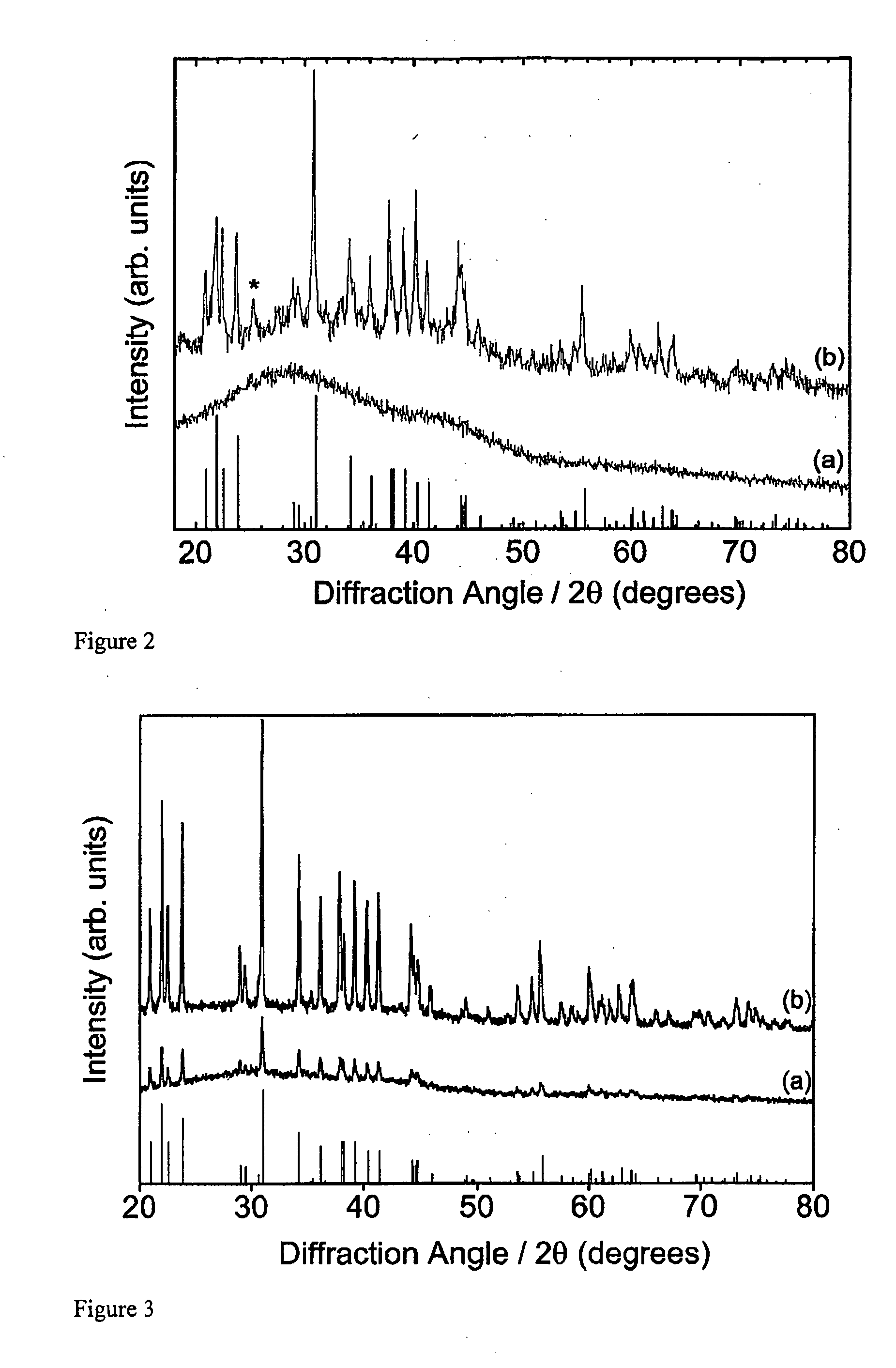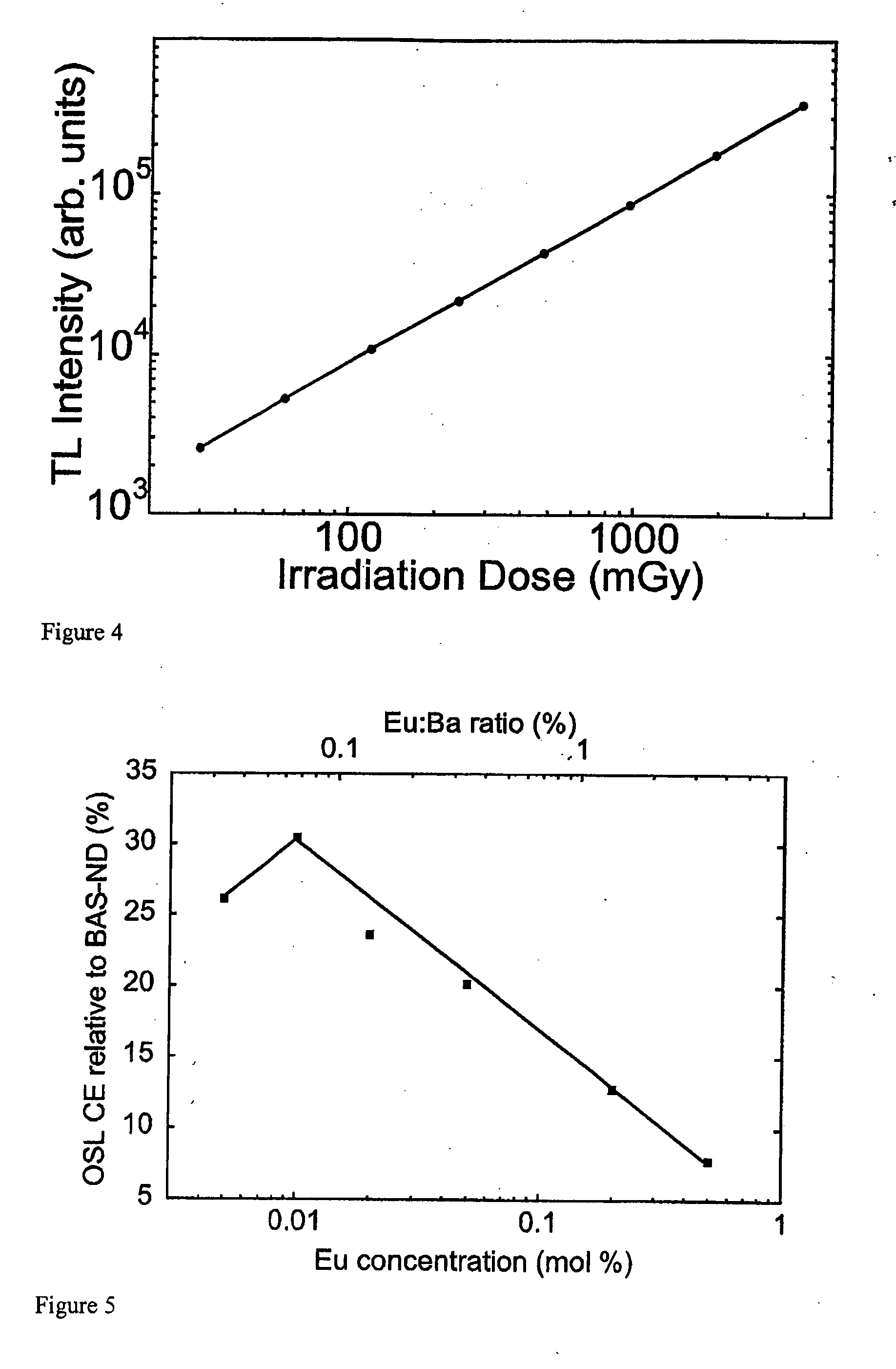Photostimulable glass ceramic
a glass ceramic and photostimulating technology, applied in the field of thermostatic neutron detection materials, can solve the problems of reducing the resulting image quality, destroying the readout process in nature, and poor spatial resolution
- Summary
- Abstract
- Description
- Claims
- Application Information
AI Technical Summary
Benefits of technology
Problems solved by technology
Method used
Image
Examples
example 1
[0118] A borate glass made from 54.5 mole % of B2)3, 24.9 mole % of Li2O, 5.0 mole % of LiF, 11.2 mole % of BaCl2, 0.5 mole % of EuCl2 and 3.9 mol % SiO2. It was quenched to 300° C. The as-made glass was amorphous as can be seen in FIG. 2(a). The glass was annealed at 520° C. for 220 minutes to produce a glassramic containing BaCl2:Eu2+ crystallites and the XRD pattern is shown in FIG. 2(b). The asterisk denotes a line of a minor phase that is due to crystallisation of the lithium borate. The standard XRD pattern (ICDD #24-0094) for orthorhombic BaCl2 is also shown. The as-made glass was not sensitive to x-rays and hence it is not expected to be sensitive to thermal neutrons. The glass-ceramic was sensitive to x-rays and had an x-ray OSL conversion efficiency of 1% relative to the BAS-ND.
example 2
[0119] A borate glass made from 52.6 mole % of B2O3, 24.3 mole % of Li2O, 4.7 mole % of LiF, 14.2 mole % of BaCl2, 0.4 mole % of EuCl2 and 3.8 mol % SiO2. It was quenched to 300° C. The as-made glass contained some small crystallites of BaCl2:Eu2+ as can be seen in FIG. 3(a). The glass-ceramic was annealed at 540° C. for 10 minutes that resulted in larger BaCl2:Eu2+ crystallites with an increased volume fraction as can be seen in FIG. 3(b). The annealed glass-ceramic was sensitive to x-rays and had an x-ray OSL conversion efficiency of 5% relative to the BAS-ND. The OSL conversion efficiency to thermal neutrons enriched with 99% 10B2O3 is 60% of the value measured in commercial Fuji NIP BAS-ND. A similar sample made without boron enrichment had a conversion efficiency of 15%. Neutron irradiation with 48 meV neutrons was performed using one of the beamlines of the IRI nuclear research reactor in Delft, the Netherlands.
[0120] It was irradiated with β-irradiation from a 90Sr / 90Y β sou...
example 3
[0123] A borate glass made from 50.3 mole % of B2O3, 14.7 mole % of Li2O, 20.8 mole % of LiF, 10.4 mole % of BaBr2, 0.4 mole % of EuCl2, 3.4 mol % SiO2 and 0.005% CuO to act as a nucleating agent. It was quenched to 300° C. The as made glass contained some nanocrystallites of orthorhombic BaBr2:Eu2+. The material was annealed at 480° C. for 10 minutes, which resulted in larger BaBr2:Eu2+ crystallites with an increased volume fraction. The glass-ceramic was sensitive to x-rays and had an x-ray OSL conversion efficiency of 0.45% relative to the BAS-ND.
PUM
| Property | Measurement | Unit |
|---|---|---|
| Temperature | aaaaa | aaaaa |
| Temperature | aaaaa | aaaaa |
| Temperature | aaaaa | aaaaa |
Abstract
Description
Claims
Application Information
 Login to View More
Login to View More - R&D
- Intellectual Property
- Life Sciences
- Materials
- Tech Scout
- Unparalleled Data Quality
- Higher Quality Content
- 60% Fewer Hallucinations
Browse by: Latest US Patents, China's latest patents, Technical Efficacy Thesaurus, Application Domain, Technology Topic, Popular Technical Reports.
© 2025 PatSnap. All rights reserved.Legal|Privacy policy|Modern Slavery Act Transparency Statement|Sitemap|About US| Contact US: help@patsnap.com



